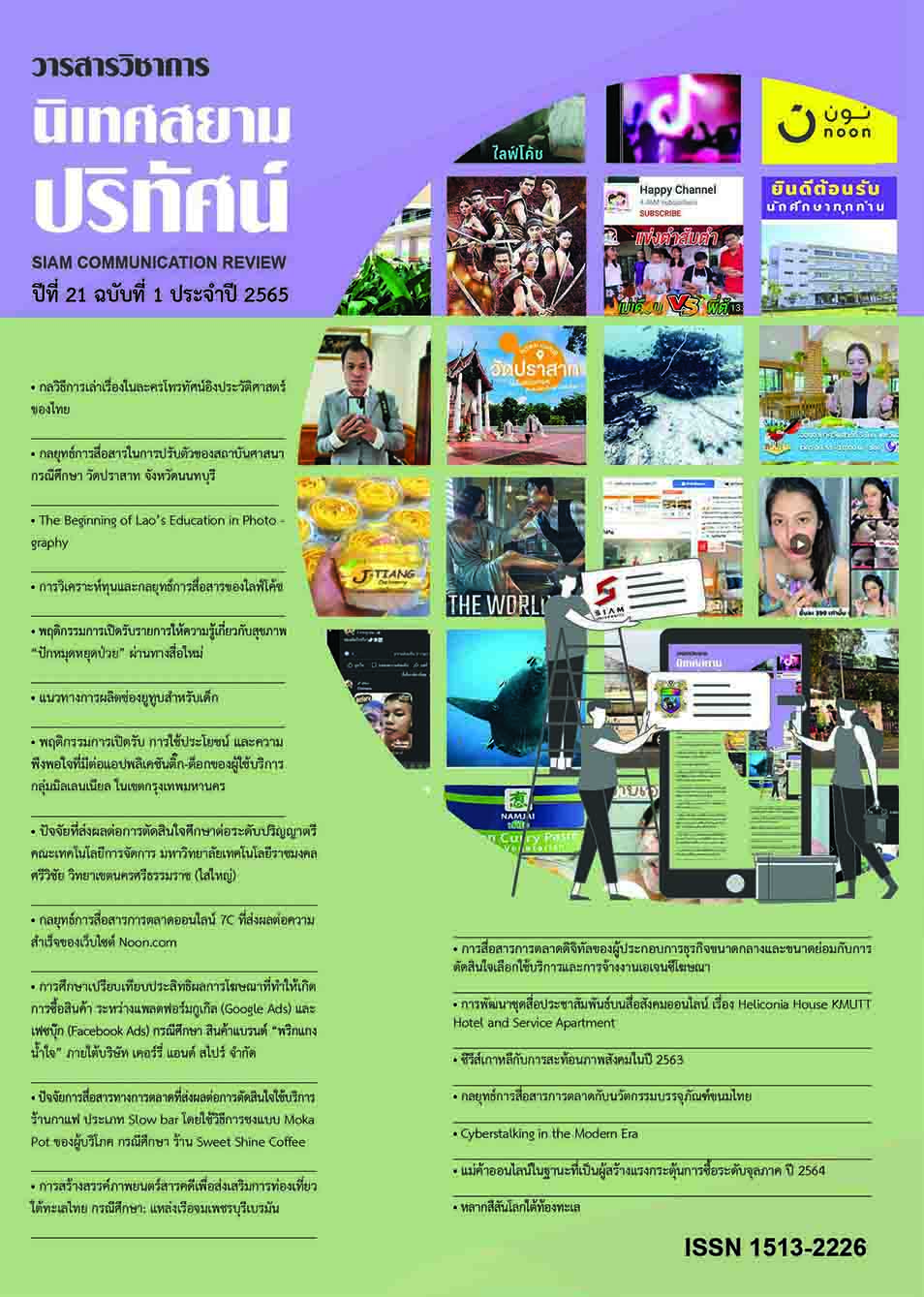Exposure Behavior, Uses, and Gratifications of the Millennial Tik-Tok Application Users in Bangkok
Main Article Content
Abstract
The purpose of this research is to examine the exposure behavior, uses, and gratifications of the Millennial Tik-Tok Application Users in Bangkok area. Online Questionnaires were used to collect the data from 400 samples. Frequency, percentage, mean, standard deviation, one-way ANOVA, and Pearson’s Product Moment Correlation Coefficient were employed for data analysis.
The results showed that the majority of Tik-Tok application users are women aged between 25 to 29 years old, earned bachelor's degree, work at private company, and having an average monthly income of 10,001 – 20,000 baht. The research demonstrates that period of time to view Tik-Tok is mostly from 20.01 to 24.00 pm., with time spending between 30 to 60 minutes per day. Behaviors of exposure to Tik-Tok applications for entertainment, recreation and stress relief, are mostly for education content (Knowledge, Skills, Teaching Education and Guidance). The uses of Tik-Tok application of Millennial group users in Bangkok are at very high level. The average use of Tik-Tok application has an overall score of 4.01 out of a full score of 5.00 while the average of gratification has an overall score of 4.14. The research also found that the millennial users’ exposure behaviors, uses and gratification of Tik-Tok application are significantly correlated at 0.01.
Article Details

This work is licensed under a Creative Commons Attribution-NonCommercial-NoDerivatives 4.0 International License.
References
ภาษาไทย
พีระ จิระโสภณ. (2531). องค์ประกอบและกระบวนการสื่อสารในหลักการและทฤษฎีการสื่อสารมวลชน (หน่วยที่ 11,น. 433-440) นนทบุรี: มหาวิทยาลัยสุโขทัยธรรมาธิราช.
อรทัย ศรีสันติสุข. (2529). บทบาทหน้าที่ของวิทยุกระจายเสียงและวิทยุโทรทัศน์. ในเอกสารการสอนชุดวิชาความรู้เบื้องต้นเกี่ยวกับวิทยุกระจายเสียงและวิทยุโทรทัศน์ (หน่วยที่ 1-7). นนทบุรี: มหาวิทยาลัยสุโขทัยธรรมาธิราช.
ภาษาอังกฤษ
Howe, N., & Strauss, W. (2000). Millennial Rising: The Next Great Generation, New York: Random House.
Katz E , Jay G. Blumler, & Michale, G. (1974). The Used of Mass Communication: Current Perspectives on Gratifications Research. Beverly Hill: Sage.
Martin, C.A. (2005). From high maintenance to high productivity. Industrial and Commercial Training, 37(1), 39-44.
ระบบออนไลน์
กรมการปกครอง กระทรวงมหาดไทย. (2564). สถิติประชากรไทย ปี 2564. เข้าถึงได้จาก https://www.dopa.go.th/main/web_index
ประชาชาติธุรกิจ. (2561). เจาะพฤติกรรม Gen Y. เข้าถึงได้จาก https://www.prachachat.net/finance/news-211619
Aroundonline. (2021). ล่าสุด! อัปโหลดวิดีโอความยาวสูงสุด 3 นาที บนแอป TIKTOK ได้แล้ว!. เข้าถึงได้จาก https://www.aroundonline.com/tiktok/
Bangkokbanksme. (2020). 4 เครื่องมือสำคัญที่นักการตลาดยุคนี้ต้องใช้. เข้าถึงได้จาก https://www.bangkokbanksme.com/en/an-essential-tool-marketers-need-to-use
Brandbuffet. (2020). “TikTok” ขึ้นแท่นแอปฯทำเงินสูงสุด เม.ย.เดือนเดียวฟัน 78 ล้านเหรียญ แซงหน้า YouTube. เข้าถึงได้จาก https://www.brandbuffet.in.th/2020/05/tiktok-user-spending-hits-us78-million-in-april/
DailyGizmo. (2020). TikTok แรงไม่หยุด!! ยืน 1 ยอดดาวน์โหลดสูงสุดในโลก. เข้าถึงได้จาก: https://www.dailygizmo.tv/2020/03/03/tiktok-no1-download/
Passivesellingonline. (2020). Tiktok แอพโซเชียลที่มาแรงสุด ทำตลาดจีนต้องใช้. เข้าถึงได้จาก: https://www.passivesellingonline.com/tiktok-the-hot.
Thestandard. (2020). อ่านกลยุทธ์ต่อไปของ TikTok ไทย คัดกรองคอนเทนต์คุณภาพ เดินหน้าสร้างรายได้. เข้าถึงได้จาก: https://thestandard.co/tiktok-strategy-filtering-quality-content/
Workpointnews. (2020). TikTok ตั้งเป้าหมายเป็นศูนย์รวมคอนเทนต์ที่หลากหลาย รองรับการเติบโตของโลกออนไลน์. เข้าถึงได้จาก: https://workpointtoday.com/tiktok-marketing-oops-1/


